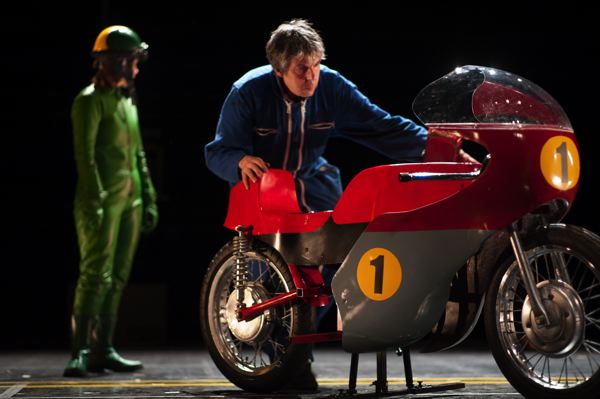Press
- 10 Oct 13 - La moto vire dans le sexe du passé PDF Article
- 10 Oct 13 - Agostini on stage PDF Article
- 6 Sep 13 - Le circuit transfiguré de Massimo Furlan PDF Article
Date(s)
- 30 mai 2014 – Rencontres du Théâtre Suisse – Winterthour (CH)
- 29-30 novembre 2013 – Südpol – Lucerne (CH)
- 22 novembre 2013 – Théâtre Benno Besson – Yverdon-les-bains (CH)
- 8-13 octobre 2013 – Théâtre de l'Arsenic – Lausanne (CH)
- 4-5 octobre 2013 – Rote Fabrik, Zurcher Tanzfestival – Zurich (CH)
- 3 et 4 septembre 2013 – La Bâtie Festival de Genève – Genève (CH)
- 6-7 mai 2013 – Les Théâtres de la Ville de Luxembourg – Luxembourg
Vidéos
https://player.vimeo.com/video/111415171Giacomo (2013)
A Massimo Furlan project.
Co-production : Théâtres de la Ville du Luxembourg; La Bâtie – Festival de Genève ; Arsenic, Lausanne; Théâtre Benno Besson, Yverdon-les-bains.
Tour : Rote Fabrik, Zürcher Tanzfefestival, Zurich; Südpol Lucerne…
Theme
The project has developed from the memory of an image – an image which was part of a playing card collection of motor cross riders. This photo, dating from the 1970’s, was of Giacomo Agostini, 15 time world champion from 1966 to 1973, wearing a black leather racing suit and a helmet with the Italian colors while astride his Agusta motorcycle.
The challenge of repetition
This project is defined by several questions which are at the core of our work. First and foremost, that of the challenge: what pushes a rider to go continually faster, attempting to beat his own record, to be faster than others, to be compete constantly, to ride beyond his limits. For the exploit, to become a hero. How does an athlete perform again and again the same gestures, the same circuits, the same races, year after year, with the same intensity and passion? He doesn’t seem to weary of this repetition. Instead, it is integral, motivating, and provides a goal – it is reassuring.
Danger : How far beyond one’s limits
Racing has a particular relationship with danger : Death takes the form of the racing circuit, of speed, but also of the machine itself. Risk is omnipresent, danger is constant, and the body is fully engaged despite everything. The rider seeks perfection, overcoming his own limits, and those of the machine. He is pushed ahead, ineluctably, as rapidly as possible: pulled by this goal, stretched to the limit, to the end.
A mechanical body
This body is a particular body, a mechanical body, meaning it is one with the motorbike, a hybrid body, a composite, half metal, half leather. A body born in an engine’s roar, smoke and speed. A cyborg from science fiction, yet already out of date, and of fashion : the model of the 1970’s motorbike, the half-moon helmet, the long hair. Anachronistic.
The question of the icon
Next, the heroic figure of Giacomo Agostini brings out the question of the icon: each individual chooses a model to imitate, whether he is a child or adult. Everyone likes to admire his icons, to observe them, to become like them. In all of Massimo Furlan’s work, he establishes a game with other’s lives, to take possession of them, to establish a dialogue with them. To create links, to construct comparisons or oppositions. To imitate the other, who is in the limelight, who is center-stage: to be their understudy, their split personality, their troubled thoughts, their source of doubt.
This process permits the telling of tales, of lies, while also encouraging thought : the question of reality and falsehood, of the original and the copy, troubling their borders, losing the sense of fiction and reality, of who, in the end, is the model for whom. At the heart of this project is the figure of the artist. The project shows several aspects, telling several stories at once, that of Agostini, that of Furlan, and that of Italy of the 1970’s.
The circular form
Naturally, the project takes the form of a circular movement, that of a track, which requires always returning to the same point. Turning round and round, always and forever, without end. The form is cyclical, repetitive, and yet, there is the final stretch. Crossing the line, which suddenly appears before you. Thus two opposing forms: that of the circle, the loop, and that of the line, of the horizon.
Massimo Furlan et Claire de Ribaupierre
